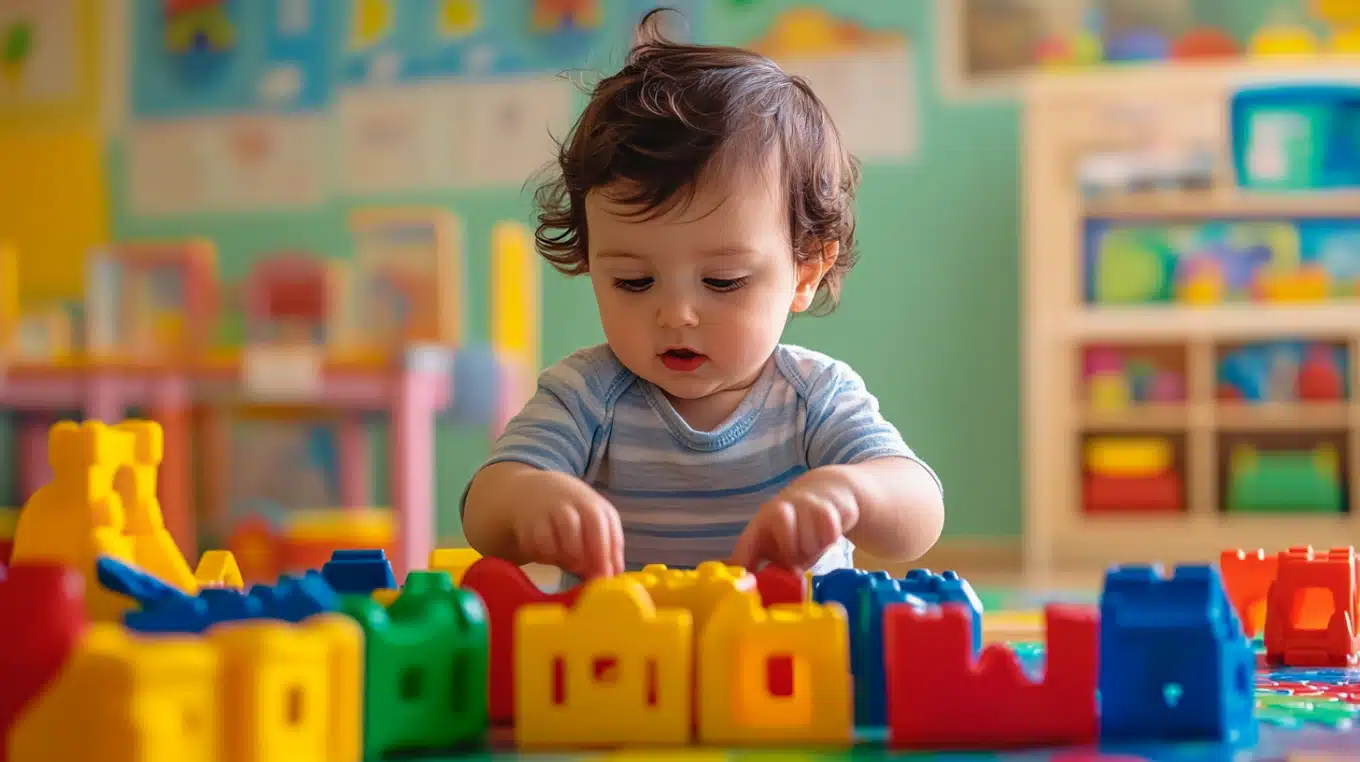We know raising a two-year-old is full of joys and tests. At this age, kids soak up everything around them like little sponges. But finding ways to keep them busy and learning can be a real task.
Don’t worry; we’ve got your back! We’ve compiled a list of activities to make learning fun for your toddler. In this post, we’ll show you 26 exciting things to do to help your two-year-old grow, learn, and have a great time.
Our ideas cover all sorts of skills – from moving their bodies to using their minds.
We’ve got simple games, creative projects, and more. There’s something here for every curious toddler.
Let’s explore these fun ideas and watch your little one bloom!
Learning Activities for 2-Year-Olds
1. Animal Parade
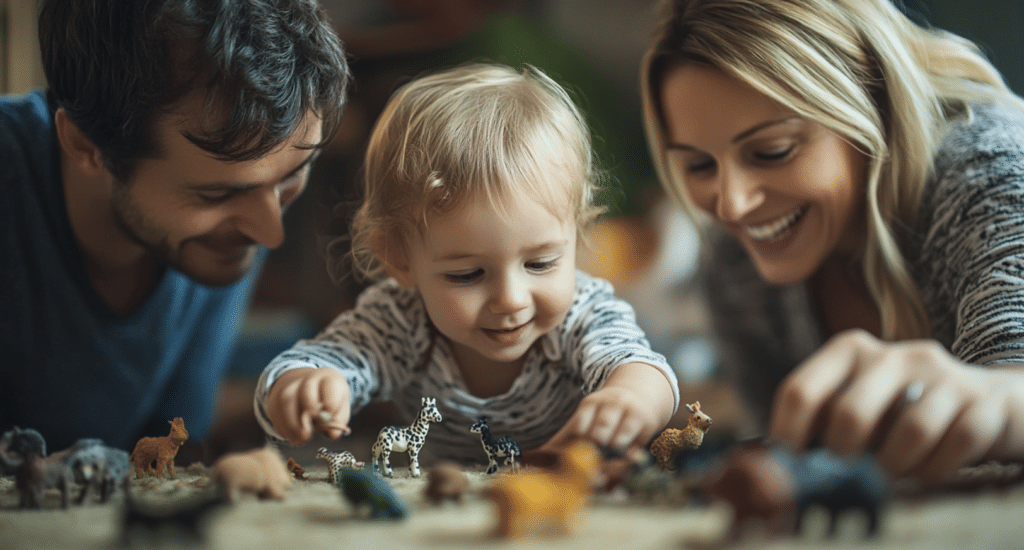
Animal Parade is a fantastic game for toddlers to learn about different animals while developing gross motor skills. This game encourages children to mimic the movements of various animals, helping them build strength and coordination while having fun.
How to Play
- Gather pictures or toys of different animals.
- Show your child one animal at a time and explain how the animal moves.
- Encourage your toddler to mimic the animal’s movement, such as hopping like a frog, waddling like a duck, or slithering like a snake.
- Join in the fun and make the game more interactive by combining animal sounds.
2. Color Hunt
Color Hunt is an engaging way to teach toddlers about colors while enhancing their observation skills. It turns everyday objects into a fun learning experience.
How to Play
- Pick a color and ask your child to find objects around the room that match the color.
- You can start with easy colors like red, blue, or yellow.
- Once they find an object, talk about the color and other characteristics.
- Repeat the process with different colors.
3. Ball Toss
Ball Toss is a simple yet effective game that improves hand-eye coordination in toddlers. It also helps them develop fine motor skills and understand cause and effect.
How to Play
- Use soft balls and a large container or basket.
- Show your child how to toss the ball into the basket.
- Please encourage them to try it themselves.
- Praise their efforts, whether they succeed or miss, and continue the game to keep them engaged.
4. Bubble Popping
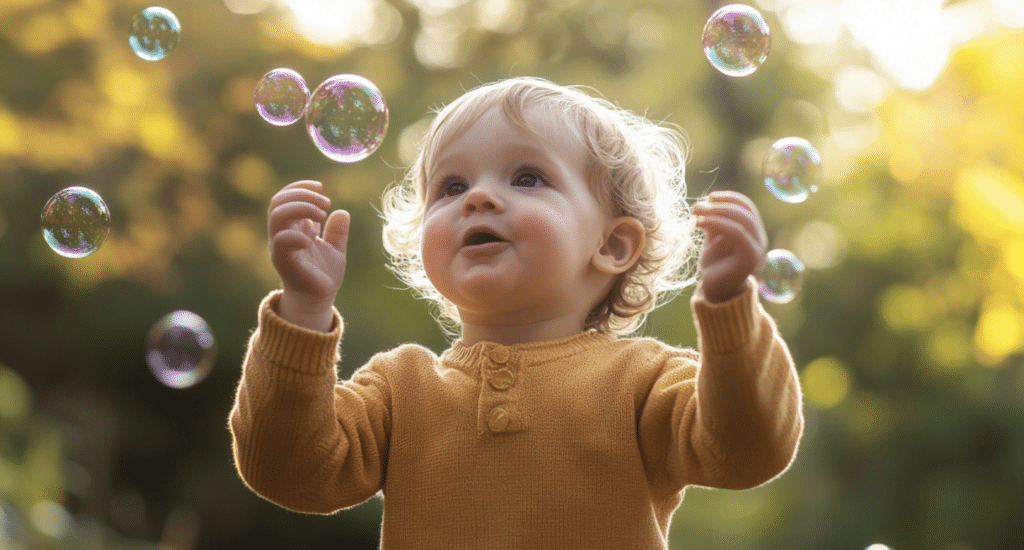
Bubble Popping is a fun and sensory-rich activity that helps toddlers develop hand-eye coordination and fine motor skills. It’s also a great way to introduce them to cause and effect.
How to Play
- Blow bubbles and encourage your child to pop them with their hands.
- As they get the hang of it, challenge them to pop the bubbles with different parts of their body, like their nose or feet.
- Keep the game light and fun, praising them for their efforts.
5. Shape Sorting
Shape Sorting helps toddlers learn about different shapes and improves their cognitive and fine motor skills. It’s an excellent way to introduce early math concepts.
How to Play
- Use a shape sorter toy with various shapes like circles, squares, and triangles.
- Show your child how to place the correct shape into the corresponding hole.
- Encourage them to try it on their own, guiding them as needed.
- Talk about each shape and its characteristics to reinforce learning.
6. Hide and Seek Toys
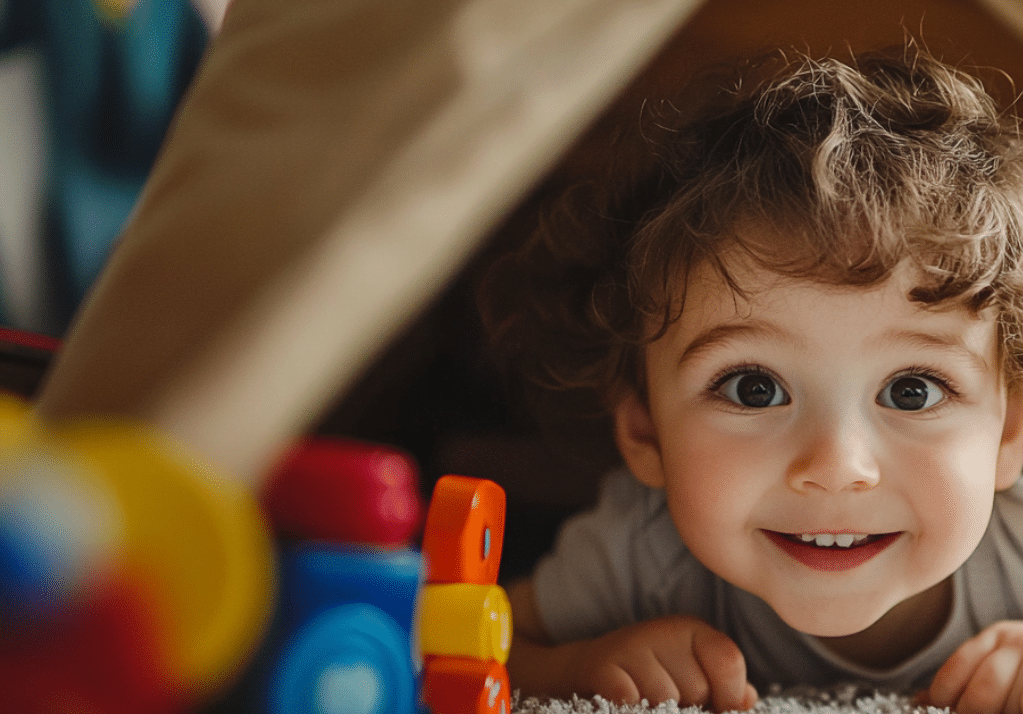
Hide and Seek Toys is a simple game that enhances a toddler’s memory and cognitive skills. It encourages them to use their problem-solving abilities to find hidden objects.
How to Play
- Choose a few of your child’s favorite toys.
- Hide the toys around the room while your child isn’t looking.
- Ask them to find the hidden toys, giving hints if necessary.
- Celebrate with them when they find each toy to keep the game exciting.
7. Sticker Match
Sticker Match is an engaging activity that helps toddlers develop fine motor skills and learn about shapes, colors, or animals. It’s also a fun way to boost their concentration.
How to Play
- Provide your child with a set of stickers and a matching chart (with corresponding images or shapes).
- Show them how to match the stickers with the images on the chart.
- Let your child peel and stick the stickers in the correct places.
- Encourage them to complete the chart, offering guidance if needed.
8. Water Play
Water Play is a sensory activity that promotes toddlers’ fine motor skills, hand-eye coordination, and creativity. It also introduces them to basic concepts of cause and effect.
How to Play
- Fill a shallow basin with water and provide cups, spoons, and small containers.
- Encourage your child to pour water from one container to another.
- Show them how to create waves, splash, and explore the different ways water moves.
- Supervise closely to ensure safety and maximize the fun.
9. Obstacle Course
Obstacle Course is a fantastic way for toddlers to develop their gross motor skills, balance, and coordination. This game also encourages problem-solving as they navigate the course.
How to Play
- Up a simple obstacle course using pillows, boxes, or soft furniture.
- Demonstrate how to crawl under, climb over, and walk around the obstacles.
- Encourage your child to complete the course at their own pace.
- Cheer them on as they navigate the course, making it more challenging as they become more confident.
10. Sensory Bin Exploration
Sensory Bin Exploration stimulates a toddler’s senses and encourages fine motor development. It also fosters creativity and independent play.
How to Play
- Fill a large container with various sensory materials, such as rice, sand, or dried beans.
- Add small toys, spoons, or cups for your child to explore.
- Encourage them to dig, pour, and sort the materials.
- Talk about the different textures and sounds to enhance the sensory experience.
11. Musical Instruments

Musical Instruments is an enjoyable way to introduce toddlers to music and rhythm. It helps them develop their auditory skills and coordination while having fun with sounds.
How to Play
- Provide simple musical instruments like drums, shakers, or xylophones.
- Show your child how to use each instrument and make different sounds.
- Please encourage them to play along with their favorite songs or create their own music.
- Join in the music-making for a fun, interactive experience.
12. Shadow Play
Shadow Play is a creative activity that helps toddlers understand light and shadow. It also stimulates their imagination and fine motor skills as they experiment with creating different shapes.
How to Play
- Set up a light source, such as a lamp or flashlight, in a dark room.
- Show your child how to use their hands or toys to create shadows on the wall.
- Encourage them to make different shapes or even create a story with the shadows.
- Experiment with moving closer or farther from the light to see how the shadows change.
13. Animal Sound Match
Animal Sound Match is a fun way for toddlers to learn about animals and the sounds they make. This game improves their listening skills and cognitive development.
How to Play
- Gather pictures of various animals or use animal toys.
- Play a recording of different animal sounds.
- Ask your child to match the sound with the correct animal picture or toy.
- Discuss the animals and their sounds to reinforce learning.
14. Balloon Volleyball
Balloon Volleyball is a safe and fun way to develop a toddler’s gross motor skills, hand-eye coordination, and teamwork. It’s an easy game to set up and play indoors.
How to Play
- Inflate a balloon and clear some space in the room.
- Show your child how to hit the balloon with their hands to keep it in the air.
- Take turns hitting the balloon back and forth, trying to keep it from touching the ground.
- Add simple rules or challenges as your child gets better at the game.
15. Sorting Colors
Sorting Colors is a simple yet effective game that helps toddlers learn about colors and improve their sorting and categorization skills.
How to Play
- Gather various colored objects, such as blocks, balls, or fabric pieces.
- Provide containers or sections on the floor for each color.
- Show your child how to sort the objects by color into the correct container.
- Please encourage them to name each color as they sort, reinforcing color recognition.
16. Indoor Bowling
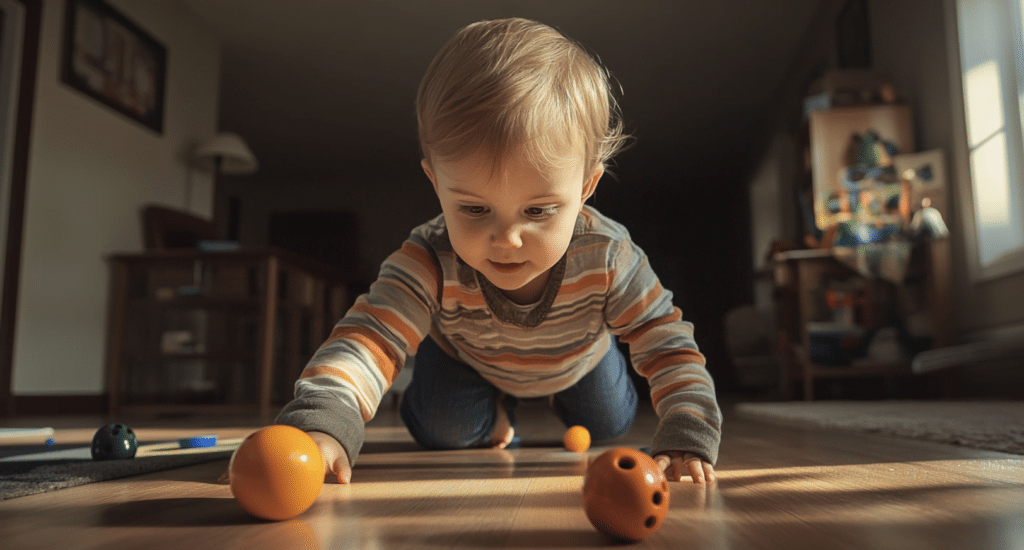
Indoor Bowling is a fun activity that helps toddlers develop their coordination, motor skills, and understanding of cause and effect.
How to Play
- Set up a few plastic bottles or soft toys as bowling pins in a hallway or open space.
- Give your child a softball and show them how to roll it to knock down the pins.
- Encourage them to take turns and count how many pins they knock down.
- Celebrate their successes and encourage them to try again to improve their aim.
17. Matching Pairs
Matching Pairs is a classic memory game that enhances a toddler’s cognitive skills and concentration. It’s a simple yet effective way to improve their memory.
How to Play
- Prepare a set of matching cards with pictures of animals, shapes, or objects.
- Lay the cards face down on the floor.
- Show your child how to flip over two cards to find a matching pair.
- Encourage them to remember the positions of the cards as they play.
18. DIY Art Collage
DIY Art Collage is a creative activity that allows toddlers to explore different textures and materials while developing their fine motor skills and creativity.
How to Play
- Provide a variety of craft materials, such as paper scraps, fabric, stickers, and glue.
- Encourage your child to arrange and glue the materials onto a large sheet of paper.
- Talk about the different textures and colors as they create their collage.
- Display their artwork to boost their confidence and creativity.
19. Sensory Path
Sensory Path is an engaging activity that helps toddlers develop their balance, coordination, and sensory awareness by walking through different textures.
How to Play
- Create a sensory path using materials like pillows, mats, textured fabrics, and foam.
- Lay the materials out in a sequence to form a path on the floor.
- Encourage your child to walk, crawl, or hop along the path, feeling the different textures with their feet and hands.
- Supervise and guide them as they explore the path.
20. Imitation Dance

Imitation Dance is a fun and energetic game that helps toddlers develop their coordination, rhythm, and listening skills. It’s also a great way to burn off some energy.
How to Play
- Play some upbeat music that your child enjoys.
- Start dancing and show your child simple dance moves to imitate.
- Encourage them to copy your moves and add their own.
- Take turns leading the dance to keep the game interactive and fun.
21. Counting Bears
Counting Bears is a playful activity that introduces toddlers to early math concepts like counting and sorting, while also improving their fine motor skills.
How to Play
- Provide a set of colorful counting bears or similar small objects.
- Show your child how to count the bears and sort them by color or size.
- Use containers or sections to organize the bears as they count.
- Reinforce the concept of numbers and counting through repetition and praise.
22. Texture Touch
Texture Touch is a sensory game that helps toddlers explore different textures and develop their tactile awareness and descriptive language.
How to Play
- Gather various objects with different textures, such as soft fabric, rough sandpaper, or smooth stones.
- Place the objects in a bag or box.
- Have your child reach in and touch each object without looking.
- Ask them to describe the texture they feel and guess what the object is.
23. Parachute Play
Parachute Play is an exciting group activity that enhances a toddler’s coordination, teamwork, and gross motor skills. It’s perfect for playdates or family fun.
How to Play
- Use a small parachute or large sheet, and have each person hold an edge.
- Show your child how to lift and lower the parachute together to create waves.
- Place lightweight balls or soft toys on the parachute and try to keep them from falling off.
- Encourage your child to work together with others to control the parachute’s movement.
24. Dress-Up Fun
Dress-Up Fun encourages imaginative play and helps toddlers develop their social skills, creativity, and self-expression through role-playing.
How to Play
- Provide a variety of dress-up clothes and accessories, such as hats, scarves, and costumes.
- Encourage your child to dress up and pretend to be different characters, like a superhero, doctor, or animal.
- Join in the role-play, taking on different roles to interact with your child.
- Let them lead the play, making up stories and scenarios.
25. Scarf Dancing
Scarf Dancing is a joyful activity that promotes movement, coordination, and rhythm in toddlers. It’s a great way to combine music and physical activity.
How to Play
- Provide colorful scarves or pieces of fabric.
- Play music and show your child how to wave the scarves in time with the rhythm.
- Please encourage them to move their body and scarves to the music, experimenting with different movements.
- Create a playful atmosphere by joining in and dancing together.
26. Nature Art
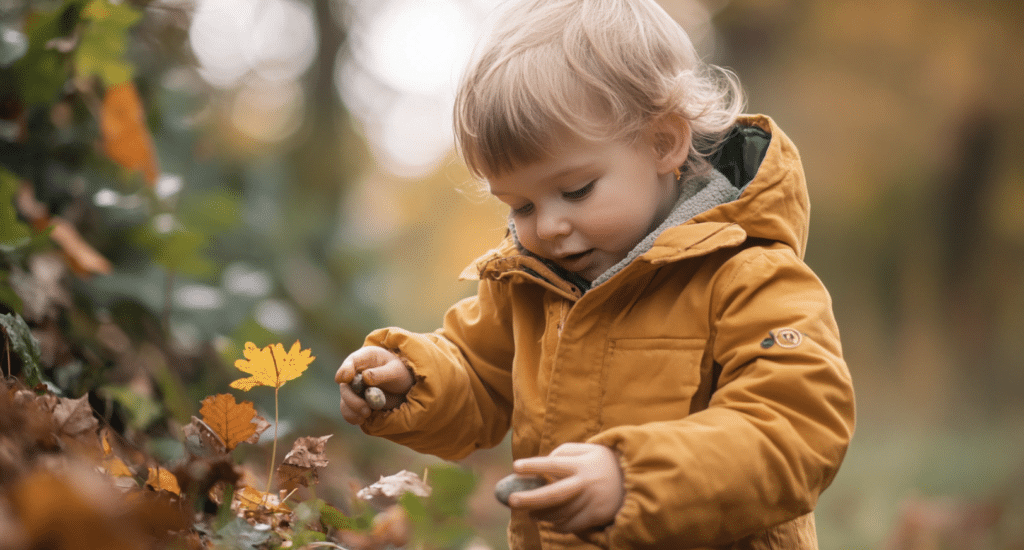
Nature Art is a creative activity that connects toddlers with nature while developing their fine motor skills and artistic expression.
How to Play
- Take your child on a nature walk to collect leaves, flowers, sticks, and stones.
- Provide a sheet of paper and glue to create a nature collage.
- Encourage your child to arrange and glue the natural items onto the paper to create a piece of art.
- Talk about the different shapes, colors, and textures as they work.
Conclusion
Let’s wrap up our journey through fun activities for two-year-olds. We’ve explored 26 ways to spark your toddler’s curiosity and help them learn.
Remember, every child grows at their own pace, so don’t worry if some activities seem too easy or hard. The key is to have fun together!
These ideas are just starting points – feel free to tweak them to suit your little one’s interests. As you play and learn with your toddler, you build a strong bond and set the stage for a lifetime of learning.
Keep in mind that the simplest things often bring the most joy.
So, grab a cardboard box, sing a silly song, or splash in some water – you’re creating precious memories and helping your child grow in wonderful ways.

